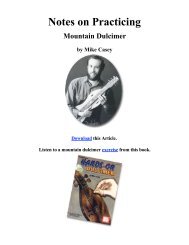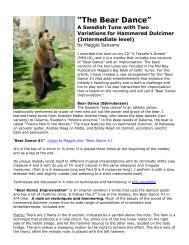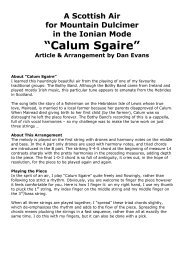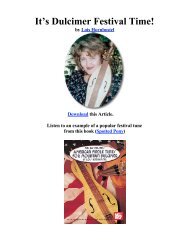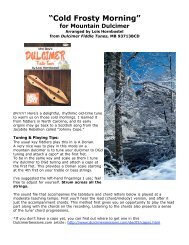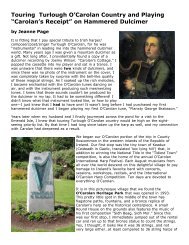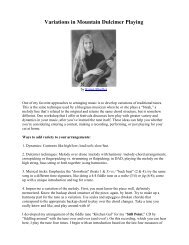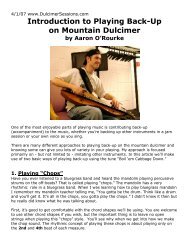Create successful ePaper yourself
Turn your PDF publications into a flip-book with our unique Google optimized e-Paper software.
<strong>The</strong> <strong>Hammered</strong> <strong>Mbira</strong><br />
An Evolutionary Step<br />
of the Hammer Dulcimer<br />
Don MacLane, Inventor<br />
Interviewed by Bill Troxler<br />
<strong>The</strong> origins of most traditional musical<br />
instruments are lost in the mists of time.<br />
<strong>The</strong> seminal events that gave us flutes,<br />
violins, banjos, dulcimers and other familiar<br />
instruments are unknown and unlikely to be<br />
discovered. But this is not the case with the<br />
newest form of the dulcimer – the<br />
hammered mbira. <strong>The</strong> inventor is known.<br />
His purpose is clearly stated. And the voice<br />
of the instrument is making itself heard.<br />
This article provides an interview with Don<br />
MacLane, inventor and builder of the<br />
hammered mbira.<br />
About Don MacLane. Few people bring<br />
the rich experience of Don MacLane to the<br />
craft of building musical instruments. Don<br />
holds bachelors and masters degrees in<br />
sculpture from Antioch College and the University of Oregon. He trained as a cabinetmaker to<br />
make custom hardwood furniture and is also an experienced blacksmith. Don worked for years<br />
as a steel fabricator focusing on structural steel, cranes, machinery and pressure vessels. He<br />
earned a bachelors degree in mechanical engineering and for twenty years worked on design<br />
and development of color printers at Tektronix and Xerox. Since 2006 Don has devoted full time<br />
to sculpture, music and the invention of new musical instruments.<br />
BT: Let’s begin with the name of the instrument. What is an mbira?<br />
DM: <strong>The</strong> name is pronounced em-beer- uh.<br />
<strong>The</strong> mbira is a melodic instrument of the Shona people of Zimbabwe. Throughout Africa there<br />
are numerous examples of this type of instrument with many different names. Of all of these<br />
instruments, the mbira of the Shona people may be the most complex.<br />
<strong>The</strong> mbira typically consists of several rows of metal tines clamped to a wooden board. <strong>The</strong>se<br />
tines, or keys, produce tones when plucked. <strong>The</strong> keys are typically hammered from steel wire.<br />
<strong>The</strong>ir length, width and thickness are adjusted to achieve the desired pitch and tonal color. <strong>The</strong><br />
musician strokes the tips of the keys with thumb or fingertips. <strong>The</strong> wooden platform of the mbira<br />
is commonly placed inside a calabash gourd resonator to increase its volume.
BT: Can you describe the hammered mbira?<br />
DM: <strong>The</strong> hammered mbira is a tuned percussion instrument based on a combination of the<br />
African mbira with a hammered dulcimer. Metal rods are clamped in brass bridges that are<br />
bolted to a soundboard. <strong>The</strong> rods are tuned to a diatonic scale and arranged in a note pattern<br />
identical to contemporary hammered dulcimers. <strong>The</strong> hammered mbira is played, in the same<br />
way as a hammered dulcimer, by striking the rods with small hammers.<br />
BT: Can you describe the voice of the hammered mbira? Is it anything like a hammer<br />
dulcimer?<br />
DM: <strong>The</strong> voice is unique. Listeners often describe the voice of the hammered mbira as lying<br />
somewhere between steel drums and a marimba. It is a happy, engaging sound but shares little<br />
in common with the sonic footprint of a hammer dulcimer.<br />
You can listen to the hammered mbira play two familiar tunes in the sound files that accompany<br />
this interview.<br />
To hear the instrument’s lyrical voice, listen to “Sí Bheg Sí Mhor.”<br />
To hear the aggressive voice, of the hammered mbira listen to “Sandy Boys.”<br />
BT: What is the range of the hammered mbira?<br />
DM: <strong>The</strong> range of standard 12/11 hammer dulcimer would fit exactly within the range of the<br />
13/12 hammered mbira. It is exactly the same set of tones that appears on the upper end of a<br />
D-500 Dusty Strings hammer dulcimer.<br />
BT: How do you tune the hammered mbira?
DM: Tuning is accomplished by moving and then securing small weights located near the end of<br />
the rods. This is done at the end of construction using a strobe tuner. Unless the weights shift<br />
position, no further tuning adjustment should be required.<br />
BT: Does the hammered mbira use different<br />
hammers than the hammer dulcimer?<br />
DM: Since the tonal color is strongly influenced by<br />
the weight and density of the hammers, I supply<br />
two sets of playing hammers with different head<br />
weights, and hardness. A hard wooden-face<br />
hammer, like you might use playing hammer<br />
dulcimer in a dance band, produces a shrill,<br />
unpleasant, clattering sound on the hammered<br />
mbira. Players have experimented with different<br />
surface material. I know that Ken Kolodner and Bill<br />
Troxler both use Dr. Scholl’s thick moleskin on<br />
their hammers.<br />
BT: What materials go into a hammered<br />
mbira?<br />
DM: Stainless steel rods spaced at 1.125" are the<br />
sounding element of the instrument. Each has a<br />
small weight near their end. <strong>The</strong> bars are clamped<br />
in polished brass bridges. <strong>The</strong> bridges are bolted to<br />
the soundboard with padauk riser blocks. <strong>The</strong><br />
trapezoidal soundboard is made of Sitka spruce.<br />
BT: What motivated you to invent the<br />
hammered mbira?<br />
DM: I spent a lot of time traveling and needed an<br />
instrument that was easy to carry along. Small, tough and with very stable tuning, the mbira<br />
seemed the ideal musical instrument for a traveler. Since I wanted to be able to maintain my<br />
skill on the hammered dulcimer, I hit on the idea of laying an mbira out in the form of a<br />
hammered dulcimer and using<br />
hammers to strike the keys. <strong>The</strong><br />
strings were replaced with steel<br />
rods clamped to brass bridges.<br />
<strong>The</strong> lengths of the rods, together<br />
with size and position of small<br />
brass weights near the ends of<br />
the rods, set the<br />
tuning. Since those physical<br />
attributes are unaffected by<br />
humidity and don’t stress the<br />
instrument, the tuning is very<br />
stable. I ended up with a<br />
compact, rugged instrument that<br />
I already knew how to play and<br />
could travel with easily.
BT: Hammer dulcimers are available in many different models and sizes. Is this also<br />
true for the hammered mbira?<br />
DM: I build 8/7, 10/9 and 13/12 versions of the hammered mbira. <strong>The</strong> “industrial” model 13/12<br />
is a very rugged, soundboard only instrument.<br />
Don MacLane lives near Portland, Oregon.<br />
Visit his website to see his hammered mbiras and sculpture.<br />
www.donmaclane.com<br />
Visit author Bill Troxler’s website. www.billtroxler.com



